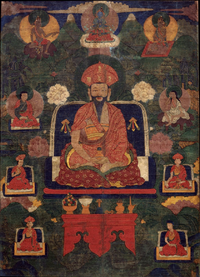Chogyal
Template:Infobox former monarchy
The Chogyal ("Dharma Kings", Tibetan: ཆོས་རྒྱལ, Wylie: chos rgyal, Sanskrit: धर्मराज dharmarāja) were the monarchs of the former kingdom of Sikkim in present-day India, which belonged to the Namgyal dynasty. The Chogyal was the absolute monarch of Sikkim from 1642 to 1975, when the monarchy was abolished and its people voted in a referendum to make Sikkim the 22nd state of India.[1][2]
History[edit | edit source]
From 1642 to 1975, Sikkim was ruled by the Namgyal Monarchy (also called the Chogyal Monarchy), founded by Phuntsog Namgyal, the fifth-generation descendant of Guru Tashi, a prince of the Minyak House who came to Sikkim from the Kham province of Tibet.[3] Chogyal means 'righteous ruler', and was the title conferred upon Sikkim's Buddhist kings during the reign of the Namgyal Monarchy.[citation needed]
The reign of the Chogyal was foretold by the patron saint of Sikkim, Guru Rinpoche. The 8th-century saint had predicted the rule of the kings when he arrived in the state. In 1642, Phuntsog Namgyal was crowned as Sikkim's first Chogyal in Yuksom. The crowning of the king was a great event and he was crowned by three revered lamas who arrived there from three different directions, namely the north, west, and south.
Chogyal kings of Sikkim[edit | edit source]
List of Chogyals[edit | edit source]
Template:Succession table monarch The son from the first marriage of Palden Thondup Namgyal, Wangchuk Namgyal (Sikkimese: དབང་ཕྱུག་བསྟན་འཛིན་རྣམ་རྒྱལ་; born 1 April 1953), was named the 13th Chogyal after his father's death on 29 January 1982,[4] but the position no longer confers any official authority.
Royal Flag[edit | edit source]
Royal Flag of Sikkim 1877–1975.
Chogyal king of Bhutan[edit | edit source]
In Bhutan, "dharmaraja" or "Righteous King" is a title which was also conferred upon a special class of temporal and spiritual rulers. In Bhutan, the Chogyal were given the respectful title Zhabdrung. In this context, the Chogyal was a recognised reincarnation (or succession of reincarnations) of Shabdrung Ngawang Namgyal, the 17th century Tibetan-born founder of Bhutan. A position of supreme importance, the Bhutanese Chogyal was above both the highest monastic authority, the Je Khenpo, and the highest temporal ruler, the Deb Raja or Druk Desi.[5] There were two main lines of Zhabdrung incarnations in Bhutan.
Gyalpo of Ladakh[edit | edit source]
The region of Ladakh was ruled by a separate line of the Namgyal dynasty that lasted from 1460 to 1842 and were titled the Gyalpo of Ladakh.[6]
See also[edit | edit source]
Notes[edit | edit source]
References[edit | edit source]
- ↑ G. T. (1 March 1975), "Trouble in Sikkim", Index on Censorship, 4: 68–69, doi:10.1080/03064227508532403, S2CID 220927214
- ↑ "Sikkim Votes to End Monarchy, Merge With India". The New York Times. 16 April 1975. Retrieved 4 September 2020.
- ↑ Measuroo.com States and Territories of India series. Online: [1] (accessed: 14 May 2008)
- ↑ "Palden Thondup Namgyal, Deposed Sikkim King, Dies". The New York Times. 30 January 1982. Retrieved 4 September 2020.
The deposed King of Sikkim, Palden Thondup Namgyal, who had been undergoing treatment for cancer in New York City, died last night from complications following an operation at Memorial Sloan Kettering Cancer Center. He was 58 years old. A family spokesman said his body was to be flown home to Sikkim for the funeral. ...
- ↑ Norbu, Namkhai (1988, 2000). The Crystal and the Way of Light: The Teachings of Namkhai Norbu. (Snow Lion Publications) pg.20 and Notes.
- ↑ Teg Bahadur Kapur (1987). Ladakh, the Wonderland A Geographical, Historical, and Sociological Study. Mittal Publications. p. 57. ISBN 9788170990116.



